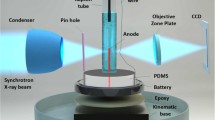Abstract
Practical methods are described in detail for the construction of tungsten microelectrodes. Straightened 127 μm-diameter tungsten wires are etched to sharp points in KNO2 solution. The sharpened wires are insulated by collapsing borosilicate-glass capillaries onto them in a horizontal pipette puller. A novel technique is described for the removal of insulation from electrode tips by embedding them in a softened bead of solder glass. The bead is then allowed to cool, producing clean fractures of the borosilicate glass at the surface of the bead; the bare, undamaged tip of the electrode is then withdrawn. Electrodes with bare tips from 2 μm to more than 100 μm can be prepared with this method. Finally, the tips are plated with a gold cyanide solution and platinum black. The finished electrodes have tapers of less than 2° and yet are extremely strong. Electrodes with conical plated tips 20 μm long by 6 μm diameter have 1 kHz impedances of less than 1 MΨ.
Sommaire
Des méthodes pratiques pour la construction de microélectrodes en tungstène sont décrites en détail. Des fils droits de tungstène de 127 μm de diamètre sont affûtés par attaque chimique dans une solution de KNO2. Les fils affûtés sont isolés en épaississant sur eux des tubes capillaires en verre au borosilicate dans un étireur de pipette horizontal. Une technique nouvelle pour retirer l'isolant des pointes d'électrodes en les ensevelissant dans une bille de verre au sodium ramolli est décrite. La bille en se refroidissant produit une rupture nette du verre au borosilicate au niveau de la bille; la pointe dénudée et non endommagée de l'électrode est alors retirée. Des électrodes à pointe dénudée allant de 2 μm à plus de 200 μm, peuvent être préparées par cette méthode. Les pointes sont enfin plaquées dans une solution de cyanure d'or et au noir de platine. Les électrodes ainsi finies ont un angle de pointe de moins de 2° et sont pourtant extrèmement robustes. Des électrodes de 20 μm de long et 6 μm de diamètre, à pointe conique plaquée ont une impédance de moins de 1 MΨ à 2 kHz.
Inhaltsangabe
Praktische Verfahren für die Herstellung von Wolframmikroelektroden werden eingehend beschrieben. Gestreckte Worlframdrähte von 127 μm Durchmesser werden in einer KNO2-Lösung zu scharfen Spitzen geätzt. Die zugespitzten Drähte werden durch Aufschmelzen von Kapillarröhrchen aus Borsilikatglas in einem horizontalen Pipettenzieher isoliert. Ein neues Verfahren für die Entfernung der Isolation von Elektrodenspitzen durch Eintauchen in eine erweichte Bleiglasperle wird beschrieben. Das nachfolgende Abkühlen der Perle erzeugt einen sauberen Bruch des Borsilikatglases an der Perlenoberfläche; danach wird die blanke, unbeschädigte Elektrodenspitze herausgezogen. Elektroden mit abisolierten Spitzen von 2 μm bis über 200 μm können mit dieser Methode hergestellt werden. Zum Schluß werden die Spitzen mit einer Goldzyanidlösung und Platinschwarz überzogen. Die fertigen Elektroden weisen eine Verjüngung von unter 2° auf und sind dennoch äußerst stark. Elektroden mit konischen plattierten Spitzen von 20 μm Länge und 6 μm Durchmesser haben bei 2 kHz Impedanzen von weniger als 1 MΨ.
Similar content being viewed by others
References
Alexander, J. T. andNastuk, W. L. (1953) An instrument for the production of microelectrodes used in electrophysiological studies.Rev. Sci. Instr. 24, 528–531.
Baldwin, H. A., Frenk, S. andLettvin, J. Y. (1965) Glass-coated tungsten microelectrodes.Science 148, 1462–1464.
Blum, B. andJohnston, A. (1969) The controlled preparation metal microelectrodes.Israel J. Med. Sci. 5, 1256–1259.
Clark, W. M. (1928) InThe determination of hydrogen ions, 3rd Edn., p. 285, Bailliere, Tindall & Cox, London.
Cool, S. J., Crawford, M. L. J. andScheer, I. J. (1970) Tungsten microelectrode preparations for CNS recording.Rev. Sci. Instr. 41, 1506–1507.
Frank, K. andBecker, M. C. (1964) Microelectrodes for recording and stimulation, 22–87, InPhysical techniques in biological research, Ed. Nastuk, W.L. Vol. 5. Academic Press, New York.
Freeman, J. A. (1969) A simple method of producing in quantity, metal microelectrodes with a desired taper and impedance.Electroenceph. Clin. Neurophysiol. 26, 623–626.
Grundfest, H., Sengstaken, R. W. andOettinger, W. H. (1950) Stainless steel micro-needle electrodes made by electrolytic pointing.Rev. Sci. Instr. 21, 360–361.
Guld, C. (1964) A glass-covered platinum microelectrode.Med. Electron. Biol. Eng. 2, 317–327.
Hubel, D. M. (1957) Tungsten microelectrode for recording from single units.Science 125, 549–550.
Kinnard, M. A. andMaclean, P. D. (1967) A platinum micro-electrode for intracerebral exploration with a chronically fixed stereotaxic device.Electroenceph. Clin. Neurophysiol. 22, 183–186.
Marg, E. (1964) A rugged, reliable and sterilizable microelectrode for recording from units from the brain.Nature 202, 601–603.
Mills, L. W. (1962) A fast, inexpensive method for producing large quantities of metallic microelectrodes.Electroenceph. Clin. Neurophysiol. 14, 278–279.
Robinson, D. A. (1968) The electrical properties of metal microelectrodes.Proc. Inst. Elect. Electron. Engrs. 56, 1065–1071.
Schanne, O. F., Lavallée, M., Laprade, R. andGagné, S. (1968) Electrical properties of glass microelectrodes.Proc. Inst. Elect. Electron. Engrs. 56, 1072–1082.
Spinelli, D. N., Bridgeman, B. andOwens, S. (1970) A simple single-unit microelectrode recording system.Med. Biol. Eng. 8, 599–602.
Tielen, A. M., Giesen, C. andMollevanger, W. (1971) Some mechanical and electrical characteristics of metal microelectrodes.Inst. of Medical Physics TNO report 2.3.65/1 MEI 1971, Utrecht, Netherlands.
Wolbarsht, M. L., Macnichol, E. F. andWagner, H. G. (1960) Glass insulated platinum microelectrode.Science 132, 1309–1310.
Author information
Authors and Affiliations
Rights and permissions
About this article
Cite this article
Merrill, E.G., Ainsworth, A. Glass-coated platinum-plated tungsten microelectrodes. Med. & biol. Engng. 10, 662–672 (1972). https://doi.org/10.1007/BF02476084
Received:
Accepted:
Issue Date:
DOI: https://doi.org/10.1007/BF02476084




